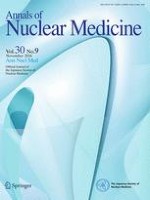01-11-2016 | Original Article
Clinical usefulness of post-treatment FDG PET/CT in patients with ovarian malignancy
Published in: Annals of Nuclear Medicine | Issue 9/2016
Login to get accessAbstract
Objective
We aimed to evaluate the diagnostic and prognostic value of post-treatment fluorine-18-fluorodeoxyglucose (FDG) positron emission tomography (PET)/computed tomography (CT) in patients treated for ovarian malignancy.
Methods
We retrospectively reviewed post-treatment PET/CT images of patients treated for histologically confirmed ovarian malignancy. The diagnostic accuracy of PET/CT for detection of disease recurrence or second primary malignancy was calculated, and the impact of PET/CT on patient management was evaluated. The association between PET/CT result and overall survival (OS) was assessed using Cox regression analysis.
Results
In total, 416 PET/CT cases of 268 ovarian malignancy patients (mean age, 50 ± 13 years) were included. Of 416 cases, 87 (21 %) were interpreted as PET/CT positive and 329 as negative. The sensitivity, specificity, accuracy, positive predictive value and negative predictive value were 98.8, 98.2, 98.3, 93.1 and 99.7 %, respectively. Of 362 cases for surveillance, changes in management occurred based on PET/CT in 38 (11 %). Of 54 cases with clinical suspicion, PET/CT ruled out disease recurrence in 9 (17 %). The median follow-up period from PET/CT imaging was 26.7 months, and 24 patients (9 %) died during the follow-up period. In univariate analyses, age, FIGO stage, history of prior recurrence and PET/CT results were significantly associated with OS. PET/CT results remained significantly associated with OS in the multivariate analysis (p < 0.05).
Conclusions
Post-treatment PET/CT was a useful modality for the detection of disease recurrence or second primary malignancy that could improve the likelihood of proper treatment and help predict outcome in patients with ovarian malignancy.





